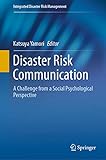Disaster Risk Communication [electronic resource] : A Challenge from a Social Psychological Perspective / Katsuya Yamori, editor.
Material type: TextSeries: Integrated Disaster Risk ManagementPublication details: Singapore : Springer, 2020.Description: 1 online resource (186 p.)ISBN:
TextSeries: Integrated Disaster Risk ManagementPublication details: Singapore : Springer, 2020.Description: 1 online resource (186 p.)ISBN: - 9789811323188
- 9811323186
- 353.9/5 23
- HV551.25
- GB3-5030
| Item type | Current library | Shelving location | Call number | Status | Date due | Barcode | Item holds | |
|---|---|---|---|---|---|---|---|---|
 Electronic Book
Electronic Book
|
Kuakarun Nursing Library | Processing unit | Online Access | eb36034 |
Description based upon print version of record.
5 Conclusion
Intro -- Foreword to the IDRiM Book Series -- Japan -- Disaster Prevention Research Institute -- International Collaboration -- Major Research Contributions -- Europe -- Integration via Regulation: European Union Experience -- International Institute for Applied Systems Analysis (IIASA) -- The USA -- Multidisciplinary Center for Earthquake Engineering Research -- Natural Hazards Center -- Center for Risk and Economic Analysis of Terrorism Events (CREATE) -- Low-Income Countries -- National Interdisciplinary Centers in the Global North -- International Centers
National and Regional Centers in the Global South -- Summary -- Other Contributions -- Conclusion -- References -- Introduction -- Contents -- Pitfall of Disaster Information -- 1 Meta-Messages -- 2 Double Bind -- 3 Double Binds Involving Disaster Information -- 4 Double Bind that Reproduces "Waiting for Information" -- 4.1 "Waiting for Information" Causing Slow Evacuation -- 4.2 The Double Bind Associated with the Message "Do not Wait for Information" -- 5 Double Bind that Reproduces Dependence on Government and Experts
6 Double Bind that Reproduces an Objective and Unequivocal View of Disaster Information -- 6.1 Is It Possible to Remove Ambiguity from Disaster Information? -- 6.2 Mutual Dependence of Disaster Information and Disaster Management -- 7 Summary-Issues and Challenges -- References -- New Approaches Toward Tsunami Risk Preparedness in Japan -- 1 Introduction -- 2 Risk Predictions -- 2.1 Characteristics of Risk Predictions -- 2.2 Three Types of Negative Attitudes -- 3 Single-Person Drills -- 3.1 Ethnographic Studies -- 3.2 Design of the Single-Person Drill -- 3.3 Implementation Processes
3.4 Products of Multiscreen Movies -- 4 Results -- 5 Theoretical Considerations -- 5.1 Artefact -- 5.2 Practice -- 5.3 Identity -- 5.4 Functions of Multiscreen Movies -- 6 Conclusion -- References -- Using Computer Simulation for Effective Tsunami Risk Communication -- 1 Introduction -- 2 Process to Create Feasible Options -- 3 Tsunami Evacuation Evaluation System (TEES) -- 3.1 Geographic Information System (GIS) -- 3.2 Multi-agent Simulation (MAS) -- 4 Implementation to Case Study Area -- 4.1 Case Study Area -- 4.2 Interview Survey -- 5 Proposal of Options Using TEES
5.1 Present State Simulation -- 5.2 Proposed Options Based on TEES -- 6 Field Activities to Verify the Feasibility of the Options -- 6.1 Workshop -- 6.2 Evacuation Drill -- 7 Discussion -- 8 Conclusion -- References -- Gaming Approach to Disaster Risk Communication: Development and Application of the "Crossroad Game" -- 1 Introduction -- 2 Challenges of Risk Communication -- 2.1 Risk Communication and Experts -- 2.2 Balance Between Self-help, Mutual Assistance, and Public Assistance -- 2.3 The Next Generation -- 3 "Crossroad" Game -- 3.1 "Crossroad: Kobe" -- 3.2 "Crossroad: Oarai" -- 4 Discussion
This book provides a unique blend of integrated disaster risk communication research conducted by authors with diverse backgrounds, including social psychology, sociology, civil engineering, informatics, and meteorology. It reports on the latest advances in collaborative and participatory action research on community-based disaster management from the frontline in Japan, Nepal, China and the USA. In addition, it employs and integrate a broad range of methodologies, including mathematical analyses, computer simulations, questionnaire surveys, gaming approaches, and participatory observation. Each chapter deals with disaster risk communication initiatives to address various hazards, such as earthquakes, tsunamis, floods and landslides, which are uniquely integrated from a social psychological perspective.
Added to collection customer.56279.3
There are no comments on this title.

